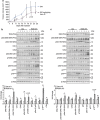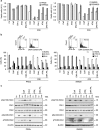The role of reactive oxygen species and subsequent DNA-damage response in the emergence of resistance towards resveratrol in colon cancer models
- PMID: 25412311
- PMCID: PMC4260744
- DOI: 10.1038/cddis.2014.486
The role of reactive oxygen species and subsequent DNA-damage response in the emergence of resistance towards resveratrol in colon cancer models
Abstract
In spite of the novel strategies to treat colon cancer, mortality rates associated with this disease remain consistently high. Tumour recurrence has been linked to the induction of resistance towards chemotherapy that involves cellular events that enable cancer cells to escape cell death. Treatment of colon cancer mainly implicates direct or indirect DNA-damaging agents and increased repair or tolerances towards subsequent lesions contribute to generate resistant populations. Resveratrol (RSV), a potent chemosensitising polyphenol, might share common properties with chemotherapeutic drugs through its indirect DNA-damaging effects reported in vitro. In this study, we investigated how RSV exerts its anticancer effects in models of colon cancer with a particular emphasis on the DNA-damage response (DDR; PIKKs-Chks-p53 signalling cascade) and its cellular consequences. We showed in vitro and in vivo that colon cancer models could progressively escape the repeated pharmacological treatments with RSV. We observed for the first time that this response was correlated with transient activation of the DDR, of apoptosis and senescence. In vitro, a single treatment with RSV induced a DDR correlated with S-phase delay and apoptosis, but prolonged treatments led to transient micronucleations and senescence phenotypes associated with polyploidisation. Ultimately, stable resistant populations towards RSV displaying higher degrees of ploidy and macronucleation as compared to parental cells emerged. We linked these transient effects and resistance emergence to the abilities of these cells to progressively escape RSV-induced DNA damage. Finally, we demonstrated that this DNA damage was triggered by an overproduction of reactive oxygen species (ROS) against which cancer cells could adapt under prolonged exposure to RSV. This study provides a pre-clinical analysis of the long-term effects of RSV and highlights ROS as main agents in RSV's indirect DNA-damaging properties and consequences in terms of anticancer response and potent resistance emergence.
Figures








References
-
- Brenner H, Kloor M, Pox CP. Colorectal cancer. Lancet. 2013;383:1490–1502. - PubMed
-
- Al-Ejeh F, Kumar R, Wiegmans A, Lakhani SR, Brown MP, Khanna KK. Harnessing the complexity of DNA-damage response pathways to improve cancer treatment outcomes. Oncogene. 2010;29:6085–6098. - PubMed
-
- Gewirtz DA. Autophagy and senescence in cancer therapy. J Cell Physiol. 2014;229:6–9. - PubMed
-
- Smith J, Tho LM, Xu N, Gillespie DA. The ATM-Chk2 and ATR-Chk1 pathways in DNA damage signaling and cancer. Adv Cancer Res. 2010;108:73–112. - PubMed
Publication types
MeSH terms
Substances
LinkOut - more resources
Full Text Sources
Other Literature Sources
Molecular Biology Databases
Research Materials
Miscellaneous

